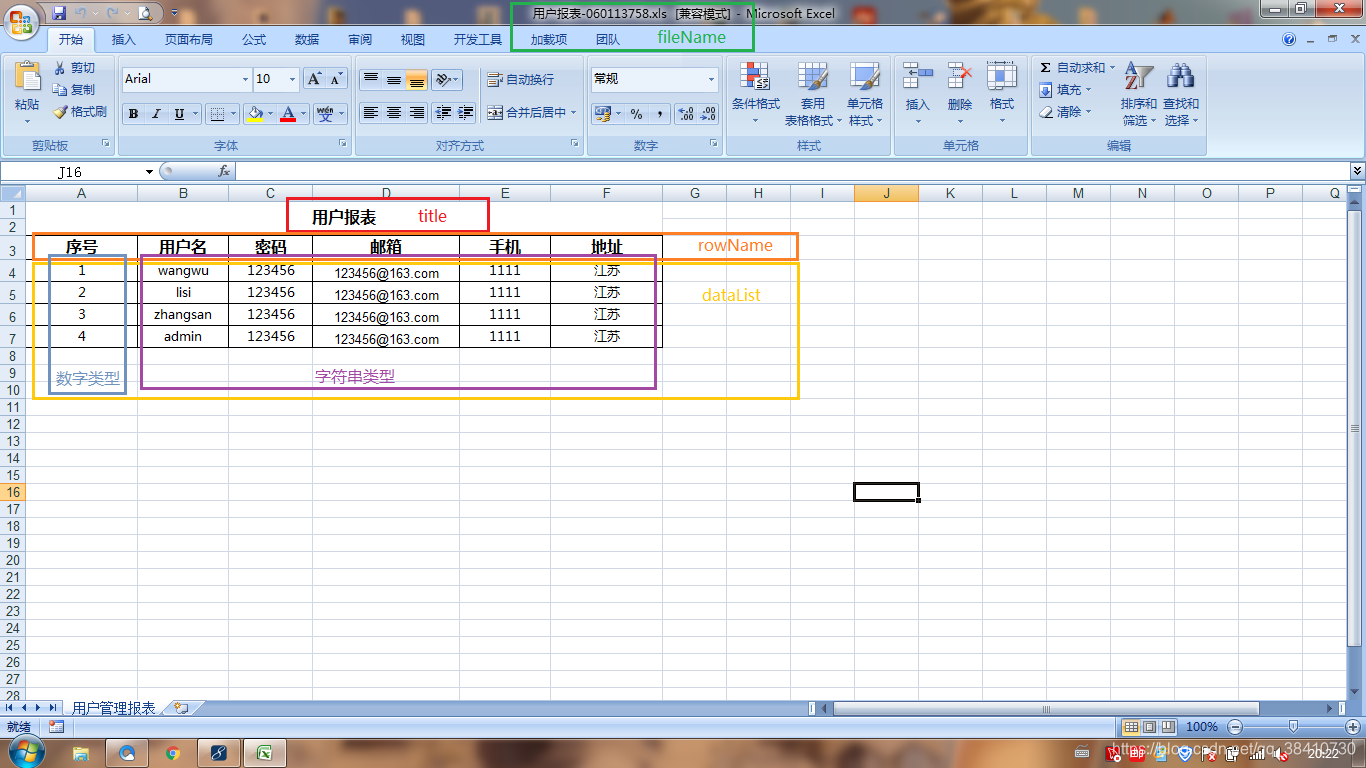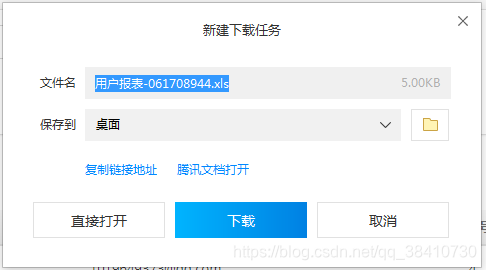在Java Web中,将内容导出到Excel文档的方式有很多,本文主要介绍以POI的方式来进行导出。
情景:浏览器页面上显示有“本地下载”的超链接,点击超链接——后台查询数据库,将数据库的内容保存到Excel中——浏览器弹出下载框,开启下载流程。
POI需要的JAR包
需要两个JAR包:poi-3.9.jar、poi-ooxml-3.9.jar。
附上两个JAR包的下载链接:poi-3.9.jar、poi-ooxml-3.9.jar。
这里也推荐一个JAR包的下载地址:Maven Repository,在里面可以下载到基本全部的JAR包。
前端JSP页面设置
应为本文主要讲的是POI方式导出到Excel,所以就只采用最简单的Servlet的方式,不用Spring这些框架了。
<body> This is my JSP page. <br/> <a href="<c:url value="/DownLoadServlet" />">本地下载</a> </body>
点击超链接之后,就会跳转到DownLoadServlet的goGet(...)方法上。
通用实体类
本来导出Excel是没有实体类的,但为了能够使程序更通用化(就像是发送邮件的Mail一样),本文也提供一个实体类来进行导出Excel的操作。
具体实体类CommonExcel的定义如下:
import javax.servlet.http.HttpServletResponse;
import org.apache.poi.hssf.usermodel.HSSFCell;
import org.apache.poi.hssf.usermodel.HSSFCellStyle;
import org.apache.poi.hssf.usermodel.HSSFFont;
import org.apache.poi.hssf.usermodel.HSSFRichTextString;
import org.apache.poi.hssf.usermodel.HSSFRow;
import org.apache.poi.hssf.usermodel.HSSFSheet;
import org.apache.poi.hssf.usermodel.HSSFWorkbook;
import org.apache.poi.hssf.util.HSSFColor;
import org.apache.poi.ss.util.CellRangeAddress;
import java.io.FileOutputStream;
import java.io.IOException;
import java.io.OutputStream;
import java.util.ArrayList;
import java.util.List;
public class CommonExcel {
// 显示的导出Excel表的标题(通常第一行)
private String title;
// 导出Excel表的列名(通常第二行)
private String[] rowName;
// 导出Excel表的文件名
private String fileName;
// 导出Excel表的文件主题内容(通常从第三行往下的内容)
// 需要注意的是:主要内容的格式为第一列为数字(序号),从第二列开始都是字符串
// 每一行为Object[]类型,很多行用List包装起来
private List<Object[]> dataList = new ArrayList<Object[]>();
// 用于下载的response
private HttpServletResponse response;
// 构造方法,传入要导出的数据
public CommonExcel(String title, String[] rowName, List<Object[]> dataList, HttpServletResponse response, String fileName) {
this.dataList = dataList;
this.rowName = rowName;
this.title = title;
this.response = response;
this.fileName = fileName;
}
// 下载Excel的方法
public void downloadExcel() throws Exception {
try {
HSSFWorkbook workbook = new HSSFWorkbook(); // 创建工作簿对象
HSSFSheet sheet = workbook.createSheet(title); // 创建工作表
// 产生表格标题行
HSSFRow rowm = sheet.createRow(0);
HSSFCell cellTiltle = rowm.createCell(0);
// sheet样式定义(两个函数均为自定义,可以自行修改)
HSSFCellStyle columnTopStyle = this.getColumnTopStyle(workbook);//获取列头样式对象
HSSFCellStyle style = this.getStyle(workbook); //单元格样式对象
sheet.addMergedRegion(new CellRangeAddress(0, 1, 0, (rowName.length - 1)));
cellTiltle.setCellStyle(columnTopStyle);
cellTiltle.setCellValue(title);
// 定义所需列数
int columnNum = rowName.length;
HSSFRow rowRowName = sheet.createRow(2); // 在索引2的位置创建行(最顶端的行开始的第二行)
// 将列头设置到sheet的单元格中
for (int n = 0; n < columnNum; n++) {
HSSFCell cellRowName = rowRowName.createCell(n); //创建列头对应个数的单元格
cellRowName.setCellType(HSSFCell.CELL_TYPE_STRING); //设置列头单元格的数据类型
HSSFRichTextString text = new HSSFRichTextString(rowName[n]);
cellRowName.setCellValue(text); //设置列头单元格的值
cellRowName.setCellStyle(columnTopStyle); //设置列头单元格样式
}
// 将查询出的数据设置到sheet对应的单元格中
for (int i = 0; i < dataList.size(); i++) {
Object[] obj = dataList.get(i); //遍历每个对象
HSSFRow row = sheet.createRow(i + 3); //创建所需的行数
for (int j = 0; j < obj.length; j++) {
HSSFCell cell = null; //设置单元格的数据类型
if (j == 0) {
cell = row.createCell(j, HSSFCell.CELL_TYPE_NUMERIC); //第一列为数字
cell.setCellValue(i + 1);
} else {
cell = row.createCell(j, HSSFCell.CELL_TYPE_STRING); //第二列起为字符串
if (!"".equals(obj[j]) && obj[j] != null) {
cell.setCellValue(obj[j].toString()); //设置单元格的值
}
}
cell.setCellStyle(style); //设置单元格样式
}
}
//让列宽随着导出的列长自动适应
for (int colNum = 0; colNum < columnNum; colNum++) {
int columnWidth = sheet.getColumnWidth(colNum) / 256;
for (int rowNum = 0; rowNum < sheet.getLastRowNum(); rowNum++) {
HSSFRow currentRow;
//当前行未被使用过
if (sheet.getRow(rowNum) == null) {
currentRow = sheet.createRow(rowNum);
} else {
currentRow = sheet.getRow(rowNum);
}
if (currentRow.getCell(colNum) != null) {
HSSFCell currentCell = currentRow.getCell(colNum);
if (currentCell.getCellType() == HSSFCell.CELL_TYPE_STRING) {
int length = currentCell.getStringCellValue().getBytes().length;
if (columnWidth < length) {
columnWidth = length;
}
}
}
}
if (colNum == 0) {
sheet.setColumnWidth(colNum, (columnWidth - 2) * 256);
} else {
sheet.setColumnWidth(colNum, (columnWidth + 4) * 256);
}
}
if (workbook != null) {
try {
if (response != null) {
response.setContentType("application/vnd.ms-excel;charset=utf-8");
response.setHeader("Content-Disposition", "attachment;filename=\""+new String(fileName.getBytes("gb2312"),"ISO8859-1"));
OutputStream out = response.getOutputStream();
workbook.write(out);
out.close();
} else {
FileOutputStream outputStream = new FileOutputStream("C:/"+fileName);
workbook.write(outputStream);
outputStream.close();
}
} catch (IOException e) {
e.printStackTrace();
}
}
} catch (Exception e) {
e.printStackTrace();
}
}
// 列头单元格样式
public HSSFCellStyle getColumnTopStyle(HSSFWorkbook workbook) {
// 设置字体
HSSFFont font = workbook.createFont();
//设置字体大小
font.setFontHeightInPoints((short) 12);
//字体加粗
font.setBoldweight(HSSFFont.BOLDWEIGHT_BOLD);
//设置字体名字
font.setFontName("微软雅黑");
//设置样式;
HSSFCellStyle style = workbook.createCellStyle();
//设置底边框;
style.setBorderBottom(HSSFCellStyle.BORDER_THIN);
//设置底边框颜色;
style.setBottomBorderColor(HSSFColor.BLACK.index);
//设置左边框;
style.setBorderLeft(HSSFCellStyle.BORDER_THIN);
//设置左边框颜色;
style.setLeftBorderColor(HSSFColor.BLACK.index);
//设置右边框;
style.setBorderRight(HSSFCellStyle.BORDER_THIN);
//设置右边框颜色;
style.setRightBorderColor(HSSFColor.BLACK.index);
//设置顶边框;
style.setBorderTop(HSSFCellStyle.BORDER_THIN);
//设置顶边框颜色;
style.setTopBorderColor(HSSFColor.BLACK.index);
//在样式用应用设置的字体;
style.setFont(font);
//设置自动换行;
style.setWrapText(false);
//设置水平对齐的样式为居中对齐;
style.setAlignment(HSSFCellStyle.ALIGN_CENTER);
//设置垂直对齐的样式为居中对齐;
style.setVerticalAlignment(HSSFCellStyle.VERTICAL_CENTER);
return style;
}
// 列数据信息单元格样式
public HSSFCellStyle getStyle(HSSFWorkbook workbook) {
// 设置字体
HSSFFont font = workbook.createFont();
//设置字体名字
font.setFontName("微软雅黑");
//设置样式;
HSSFCellStyle style = workbook.createCellStyle();
//设置底边框;
style.setBorderBottom(HSSFCellStyle.BORDER_THIN);
//设置底边框颜色;
style.setBottomBorderColor(HSSFColor.BLACK.index);
//设置左边框;
style.setBorderLeft(HSSFCellStyle.BORDER_THIN);
//设置左边框颜色;
style.setLeftBorderColor(HSSFColor.BLACK.index);
//设置右边框;
style.setBorderRight(HSSFCellStyle.BORDER_THIN);
//设置右边框颜色;
style.setRightBorderColor(HSSFColor.BLACK.index);
//设置顶边框;
style.setBorderTop(HSSFCellStyle.BORDER_THIN);
//设置顶边框颜色;
style.setTopBorderColor(HSSFColor.BLACK.index);
//在样式用应用设置的字体;
style.setFont(font);
//设置自动换行;
style.setWrapText(false);
//设置水平对齐的样式为居中对齐;
style.setAlignment(HSSFCellStyle.ALIGN_CENTER);
//设置垂直对齐的样式为居中对齐;
style.setVerticalAlignment(HSSFCellStyle.VERTICAL_CENTER);
return style;
}
}
上面这段通用实体类CommonExcel可以原封不动地直接照抄,其中有几个部分需要注明一下:
- getColumnTopStyle()、getStyle()两个函数是对列头单元格(title和rowName)、列数据单元格(dataList)进行定义格式,可以自行修改;
- 默认规定列数据单元格,第一列为数字列,从第二列开始为字符串列。
具体每个成员在最终Excel中的位置,见下图:

后台Servlet层的逻辑代码
关于数据库的读取就不展开写了,就直接调用Service层的代码了。
主要的工作就是将CommonExcel中5个参数的主要四个参数(title、rowName、dataList、fileName)初始化并赋值,最后创建CommonExcel对象,调用downloadExcel()方法就行了。
public class DownLoadServlet extends HttpServlet {
public void doGet(HttpServletRequest request, HttpServletResponse response)
throws ServletException, IOException {
this.doPost(request, response);
}
public void doPost(HttpServletRequest request, HttpServletResponse response)
throws ServletException, IOException {
// Service层获取数据库的数据
List<User> userList=userService.findAllUser();
// 定义标题(第一行)
String title = "用户报表";
// 定义列名(第二行)
String[] rowsName = new String[]{"序号","用户名","密码","邮箱","手机号","地址"};
// 定义主题内容(第三行起)
List<Object[]> dataList = new ArrayList<Object[]>();
// 定义每一行的临时变量,并放入数据
Object[] objs = null;
for (int i = 0; i < userList.size(); i++) {
objs = new Object[rowsName.length];
objs[0] = i;
objs[1] = userList.get(i).getUsername();
objs[2] = userList.get(i).getPassword();
objs[3] = userList.get(i).getEmail();
objs[4] = userList.get(i).getPhone();
objs[5] = userList.get(i).getAddress();
dataList.add(objs);
}
// 定义Excel文件名
String fileName="用户报表"+String.valueOf(System.currentTimeMillis()).substring(4,13)+".xls";
// 创建CommonExcel对象,调用downloadExcel()对象导出Excel
CommonExcel ex = new CommonExcel(title, rowsName, dataList,response,fileName);
try {
ex.downloadExcel();
} catch (Exception e) {
e.printStackTrace();
}
}
}
最终的点击页面超链接,弹出下载框:

直接点击下载,就可以下载Excel文件了,文件打开内容就是前文的Excel图片了。


 0
0









